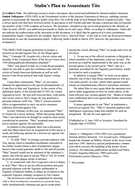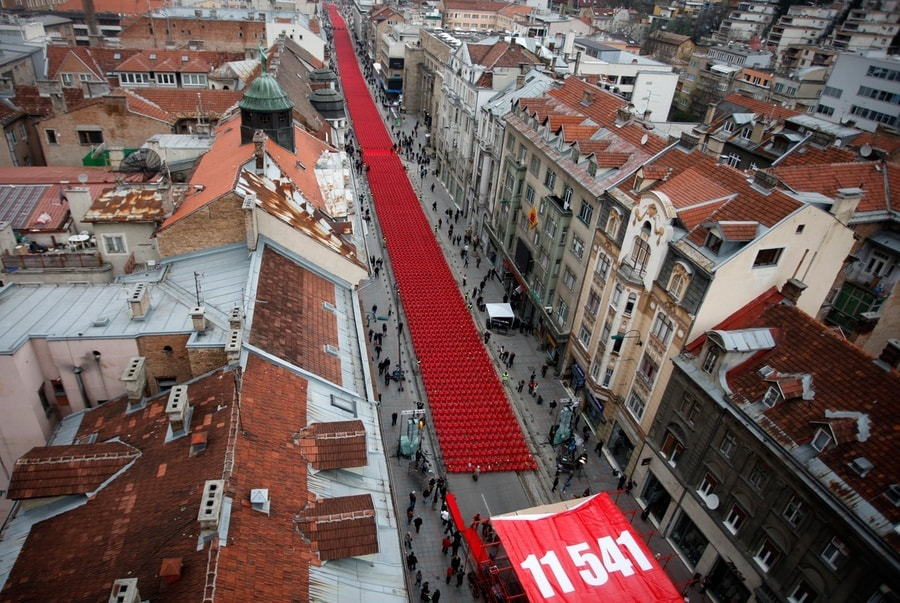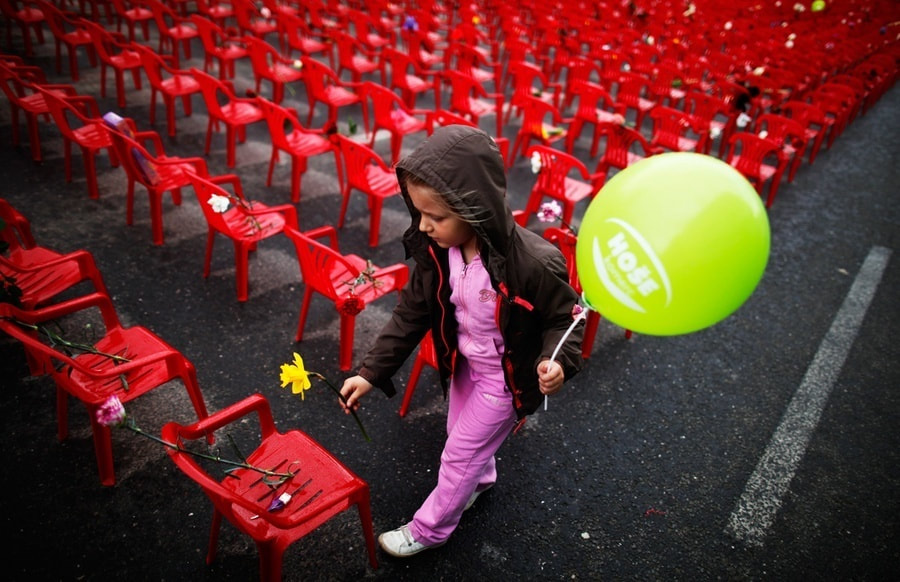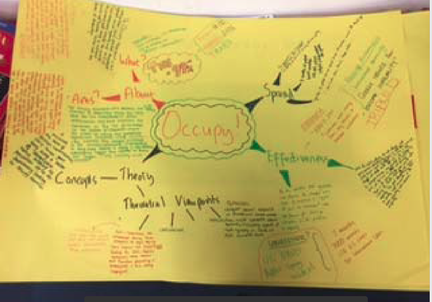Getting an Overview:
1. What were the key events in Kosovo in the lead up to the conflict?
There were many general similarities between the ethnic cleansing that occurred in Kosovo and the genocide in Rwanda. For one thing, the presence of ethnic tensions between a majority and minority group segueing with external influencers present and obvious commonality. However, a major difference would be the response of the international community. In Rwanda we saw meddling and obfuscation; in Kosovo there would be a decisive military intervention and reconstruction programme. Try to consider why the outcomes were so different as the unit progresses.
In this first lesson, we will be using the first part of a PBS documentary to get a key overview of the conflict. Remember, the purpose here is to get a general understanding of the conflict and to develop the questions (rather than all the answers) that will help guide you through this unit.
In this first lesson, we will be using the first part of a PBS documentary to get a key overview of the conflict. Remember, the purpose here is to get a general understanding of the conflict and to develop the questions (rather than all the answers) that will help guide you through this unit.
|
Click to set custom HTML
|
| ||||||||||||
2. What were the long term causes of the conflict in Kosovo? Events in the Balkans 1900-1945
1. Start with this Kahoot – questions on over view sequencing activity last lesson. Attempt to consolidate appreciation of who the different ethnic groups are, the regions / countries involved. Students refer back to original sheet to refresh sequence of events.
2. Students are split into groups to start to research one of the following periods using the textbook:
The focus is getting them to select the most important facts/events from their designated period and analyzing them in light of how they might lead to greater tension in the future.
- All groups should do the reading and pick a maximum of 7 key points from their section. They must analyse the overall significance of those points in relation to later conflict. The group should complete their part of the shared Google Doc table first.
- Students will present their period to the class. They will use this Google Slide template to do so – as they talk they must plan to annotate the first blank map on the board (basically talking through their previous main points to show changes – this should have been practiced beforehand and should be thinking about interesting presenting skills). They second slide should contain their analysis – why might these events contribute to conflict later on?
3. Complete the activity on page 141.
4. Home learning: complete some or all of the paper on page 144-145. Students hand write and receive mark/peer review.
2. Students are split into groups to start to research one of the following periods using the textbook:
- TENSIONS IN THE BALKANS 1900-1918 (p.g. 136-139)
- BETWEEN THE WARS (p.g. 139-141)
- YUGOSLAVIA IN THE SECOND WORLD WAR (p.g. 142-144)
The focus is getting them to select the most important facts/events from their designated period and analyzing them in light of how they might lead to greater tension in the future.
- All groups should do the reading and pick a maximum of 7 key points from their section. They must analyse the overall significance of those points in relation to later conflict. The group should complete their part of the shared Google Doc table first.
- Students will present their period to the class. They will use this Google Slide template to do so – as they talk they must plan to annotate the first blank map on the board (basically talking through their previous main points to show changes – this should have been practiced beforehand and should be thinking about interesting presenting skills). They second slide should contain their analysis – why might these events contribute to conflict later on?
3. Complete the activity on page 141.
4. Home learning: complete some or all of the paper on page 144-145. Students hand write and receive mark/peer review.
3. What were the long term events that led to conflict in Kosovo? Yugoslavia & Albania under Tito 1945-1980
|
|
STARTER:
Rare footage of Tito visiting Kosovo in 1979 (skip through the 6 minutes showing bits). https://www.youtube.com/watch?v=6ujVdGuf-84 - What does the clip tell us about his popularity in Kosovo? What might this suggest about his attitude to minorities in Yugoslavia? - Reflect on last lesson - what might be a Realpolitik or ideological reason why a dictator of Yougoslavia might adopt such a policy? - ToK - why do we need to be careful with this kind of evidence? |
|
Lesson Activities:
Chapter 2.6 (Click here) While we will be researching the main events in Yugoslavia under Tito this lesson, it is important for you always to be thinking "well, so what? How might these events explain later ethnic conflict in the region?" 1. Open the lesson document opposite. a) Read the five key points for a very basic overview. b) Take responsibility for A. B or C. Your duty is to make one point per paragraph in your section. c) Go to the 'Analysis Box'. From your reading, answer the question. A class discussion will follow in which four-five analysis points can be established. 2.Extension/Plenary: Complete the Weird History section of the box using the resources below. |
| ||||||
Weird History Resources:
4. What were the medium term events that led to conflict in Kosovo? a) The rise of Serbian & Kosovan Nationalism, the 'Slobodan Milosevic Myth'
Use the Video (up to 31:00) and Chapter 2.3 for this lesson.
1. Your teacher will clarify the structure of Yugoslavia 1980-89 with the help of this slide. Open the frame and complete the first box.
2. Read the five key points and then complete the research table using evidence from the video and Chapter 2.3 - you will need to finish this for homework. The video below may not work, but it is "The Fall of Milosevic-Defiance" Episode 1 BBC. You should be able to find it on youtube. The video is about getting a general idea of the "Climate" in the Yugoslav area. The textbook is more useful to fill in the table. Skip the video completely if time is short.
3. Use the questions under the grid to help you focus on the key issues for our course.
1. Your teacher will clarify the structure of Yugoslavia 1980-89 with the help of this slide. Open the frame and complete the first box.
2. Read the five key points and then complete the research table using evidence from the video and Chapter 2.3 - you will need to finish this for homework. The video below may not work, but it is "The Fall of Milosevic-Defiance" Episode 1 BBC. You should be able to find it on youtube. The video is about getting a general idea of the "Climate" in the Yugoslav area. The textbook is more useful to fill in the table. Skip the video completely if time is short.
3. Use the questions under the grid to help you focus on the key issues for our course.
|
|
| ||||||
5. Medium Term events cont: Civil Wars and the break up of Yugoslavia 1991-95
i) The Croatian and Slovenian Wars of independence & the Crushing of the Albanian Independence Campaign 1991-95
Starter:
1. QUIZ: Name the Republics, name the ethnic groups - now can you match majorities? Bonus... large minorities?
2. The video above deals with Tito until what you have covered so far in 1 minute - can you fill 30 secs? Prove it!
Watch the video until around one minute to see how you did...
1. QUIZ: Name the Republics, name the ethnic groups - now can you match majorities? Bonus... large minorities?
2. The video above deals with Tito until what you have covered so far in 1 minute - can you fill 30 secs? Prove it!
Watch the video until around one minute to see how you did...
|
Main:
Open the frame below
|
| ||||||||||||
ii) The Bosnian War 1992-1995
In April 1992, the government of the Yugoslav republic of Bosnia-Herzegovina declared its independence from Yugoslavia. Over the next several years, Bosnian Serb forces, with the backing of the Serb-dominated Yugoslav army, targeted both Bosniak (Bosnian Muslim) and Croatian civilians for atrocious crimes resulting in the deaths of some 100,000 people (80 percent Bosniak) by 1995. It was the worst act of genocide since the Nazi regime’s destruction of some 6 million European Jews during World War II. It will also lead to direct military intervention from NATO in Yugoslavia and underline the death of Tito's federation.
While this is a truly significant world event, for the purpose of our course it is sufficient to get an overview of the conflict in Bosnia while focusing our thinking on how this will increase the likelihood of tension/violence in Kosovo.
This lesson, we are going to turn the tables. You - as a class - are going to spend some time figuring things out and you are going to educate me. We have 60 minutes exactly to create a topic map that teaches me all about the Bosnian War 1992-1995.
Using giant poster paper, your map must tell me the following:
- What were the causes of the Bosnian War? (long, short etc)
- What was the general course of the war?
- Key events: Srebrenica, Stari Most (Mostar bridge), Christmas Warning, NATO air strikes
- The Dayton Accords (Reasons)
- Links to Kosovo?
You should aim to use the resources below in the first instance, but hit the textbook if you are running out of time.
Spend 2 minutes strategising for this as a class - (Google Doc, split the resources? focus questions? how will you stop duplicating tasks?)
While this is a truly significant world event, for the purpose of our course it is sufficient to get an overview of the conflict in Bosnia while focusing our thinking on how this will increase the likelihood of tension/violence in Kosovo.
This lesson, we are going to turn the tables. You - as a class - are going to spend some time figuring things out and you are going to educate me. We have 60 minutes exactly to create a topic map that teaches me all about the Bosnian War 1992-1995.
Using giant poster paper, your map must tell me the following:
- What were the causes of the Bosnian War? (long, short etc)
- What was the general course of the war?
- Key events: Srebrenica, Stari Most (Mostar bridge), Christmas Warning, NATO air strikes
- The Dayton Accords (Reasons)
- Links to Kosovo?
You should aim to use the resources below in the first instance, but hit the textbook if you are running out of time.
Spend 2 minutes strategising for this as a class - (Google Doc, split the resources? focus questions? how will you stop duplicating tasks?)
|
Links: https://www.theatlantic.com/photo/2012/04/20-years-since-the-bosnian-war/100278/ https://global.britannica.com/event/Bosnian-conflict http://www.bbc.com/news/world-europe-17212376 http://www.reuters.com/article/idUSL21644464 https://history.state.gov/milestones/1993-2000/bosnia http://foreignpolicy.com/2015/11/22/the-bosnian-war-cables/ Remembering Srebrenica/uploads/6/3/1/5/63159717/remembering_srebrenica.pdf https://www.youtube.com/watch?v=1qAA5CGC2Hg https://www.youtube.com/watch?v=3n4vw0FOJj8 Example of a 60 minute 'Teach the Teacher' whole class map; functionality over beauty.
|
| ||||||
6. Impacts to 1995 and Consolidation
i) What was the impact of the Bosnian War on Kosovo?
Discuss the presentation below and makes noted in the shared document for this lesson.
IMPACT PRESENTATION SHARED NOTE TAKING FRAME
Master
Discuss the presentation below and makes noted in the shared document for this lesson.
IMPACT PRESENTATION SHARED NOTE TAKING FRAME
Master
ii) Consolidate.
- The idea here is to review all of the note taking frames you have done so far. Have a look - are they organised? all completed? Good.
- Your teacher will give you one section of the course in pairs - you need to review using only the relevant frame completed in class and select the most important events and add them into the shared timeline, completing all columns. You must be selective, focusing on those events that best help explain the ethnic cleansing in Kosovo that will take place in 1998-99.
- Make your own copy of the shared frame.
- The idea here is to review all of the note taking frames you have done so far. Have a look - are they organised? all completed? Good.
- Your teacher will give you one section of the course in pairs - you need to review using only the relevant frame completed in class and select the most important events and add them into the shared timeline, completing all columns. You must be selective, focusing on those events that best help explain the ethnic cleansing in Kosovo that will take place in 1998-99.
- Make your own copy of the shared frame.



